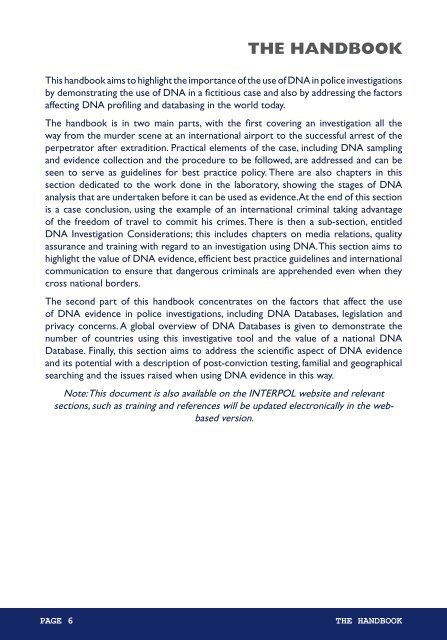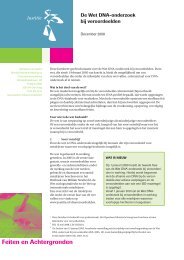INTERPOL HANDBOOK ON DNA DATA EXCHANGE AND PRACTICE
INTERPOL HANDBOOK ON DNA DATA EXCHANGE AND PRACTICE
INTERPOL HANDBOOK ON DNA DATA EXCHANGE AND PRACTICE
Create successful ePaper yourself
Turn your PDF publications into a flip-book with our unique Google optimized e-Paper software.
THE <strong>H<strong>AND</strong>BOOK</strong>This handbook aims to highlight the importance of the use of <strong>DNA</strong> in police investigationsby demonstrating the use of <strong>DNA</strong> in a fictitious case and also by addressing the factorsaffecting <strong>DNA</strong> profiling and databasing in the world today.The handbook is in two main parts, with the first covering an investigation all theway from the murder scene at an international airport to the successful arrest of theperpetrator after extradition. Practical elements of the case, including <strong>DNA</strong> samplingand evidence collection and the procedure to be followed, are addressed and can beseen to serve as guidelines for best practice policy. There are also chapters in thissection dedicated to the work done in the laboratory, showing the stages of <strong>DNA</strong>analysis that are undertaken before it can be used as evidence. At the end of this sectionis a case conclusion, using the example of an international criminal taking advantageof the freedom of travel to commit his crimes. There is then a sub-section, entitled<strong>DNA</strong> Investigation Considerations; this includes chapters on media relations, qualityassurance and training with regard to an investigation using <strong>DNA</strong>. This section aims tohighlight the value of <strong>DNA</strong> evidence, efficient best practice guidelines and internationalcommunication to ensure that dangerous criminals are apprehended even when theycross national borders.The second part of this handbook concentrates on the factors that affect the useof <strong>DNA</strong> evidence in police investigations, including <strong>DNA</strong> Databases, legislation andprivacy concerns. A global overview of <strong>DNA</strong> Databases is given to demonstrate thenumber of countries using this investigative tool and the value of a national <strong>DNA</strong>Database. Finally, this section aims to address the scientific aspect of <strong>DNA</strong> evidenceand its potential with a description of post-conviction testing, familial and geographicalsearching and the issues raised when using <strong>DNA</strong> evidence in this way.Note: This document is also available on the <strong>INTERPOL</strong> website and relevantsections, such as training and references will be updated electronically in the webbasedversion.PAGE 6THE <strong>H<strong>AND</strong>BOOK</strong>







